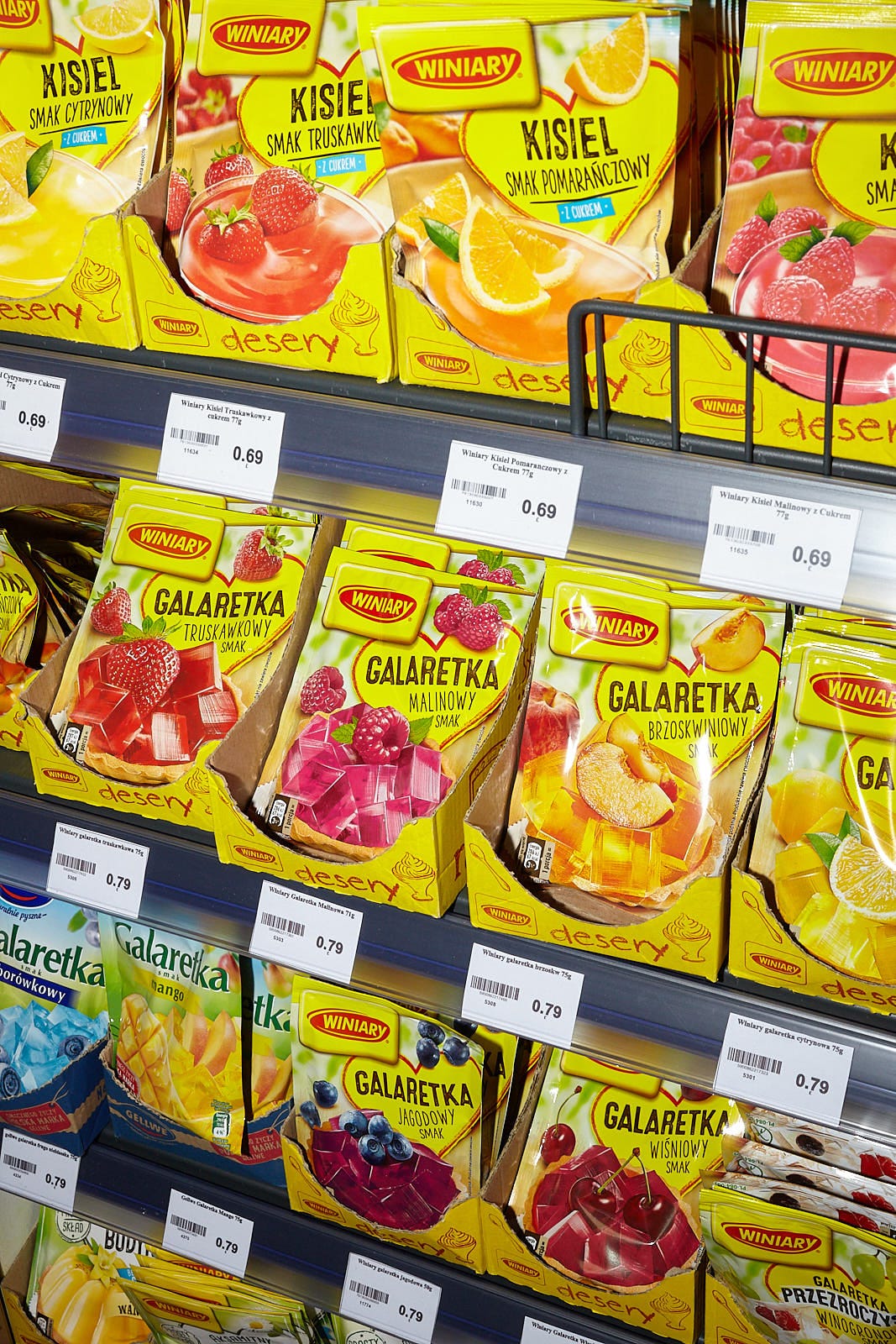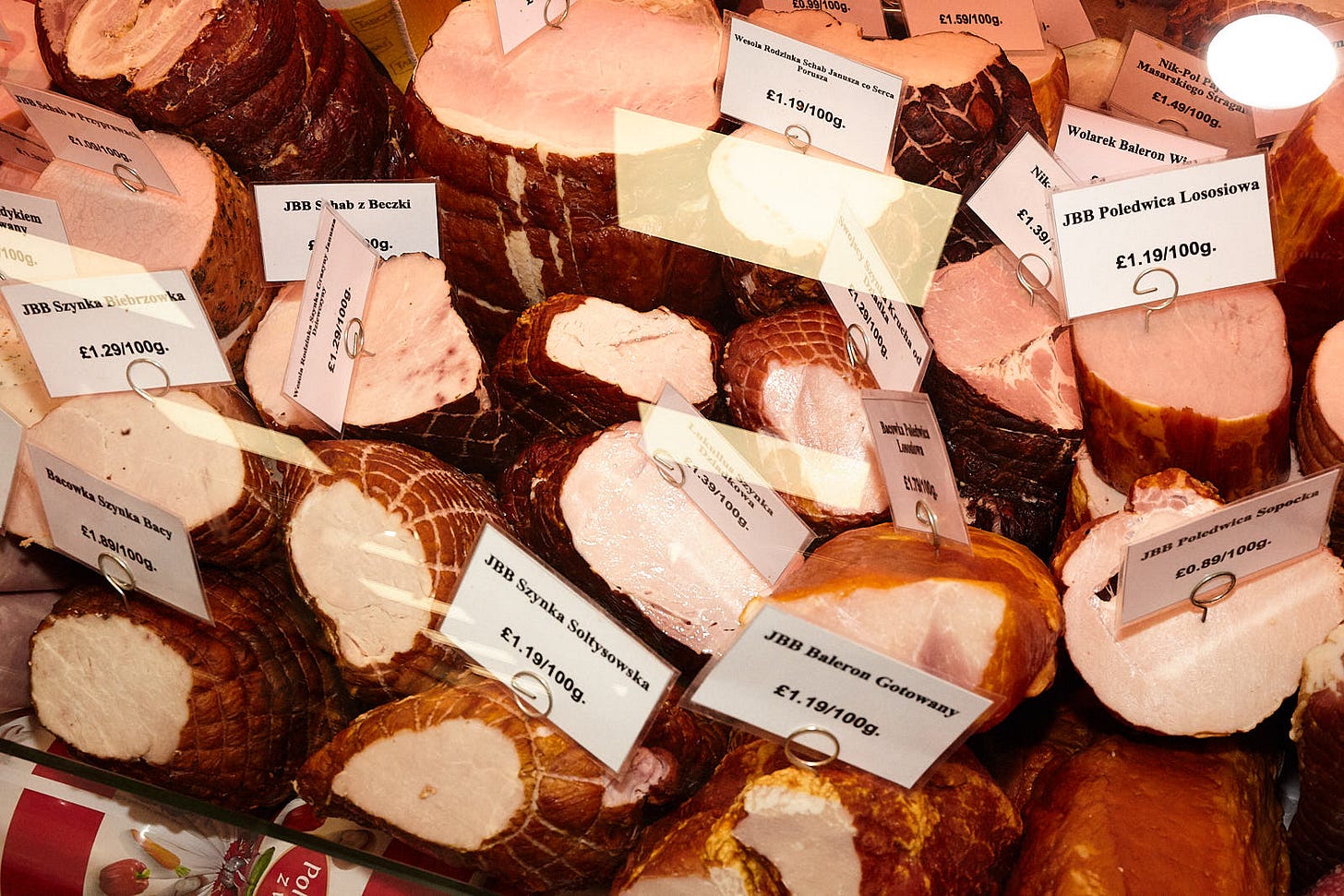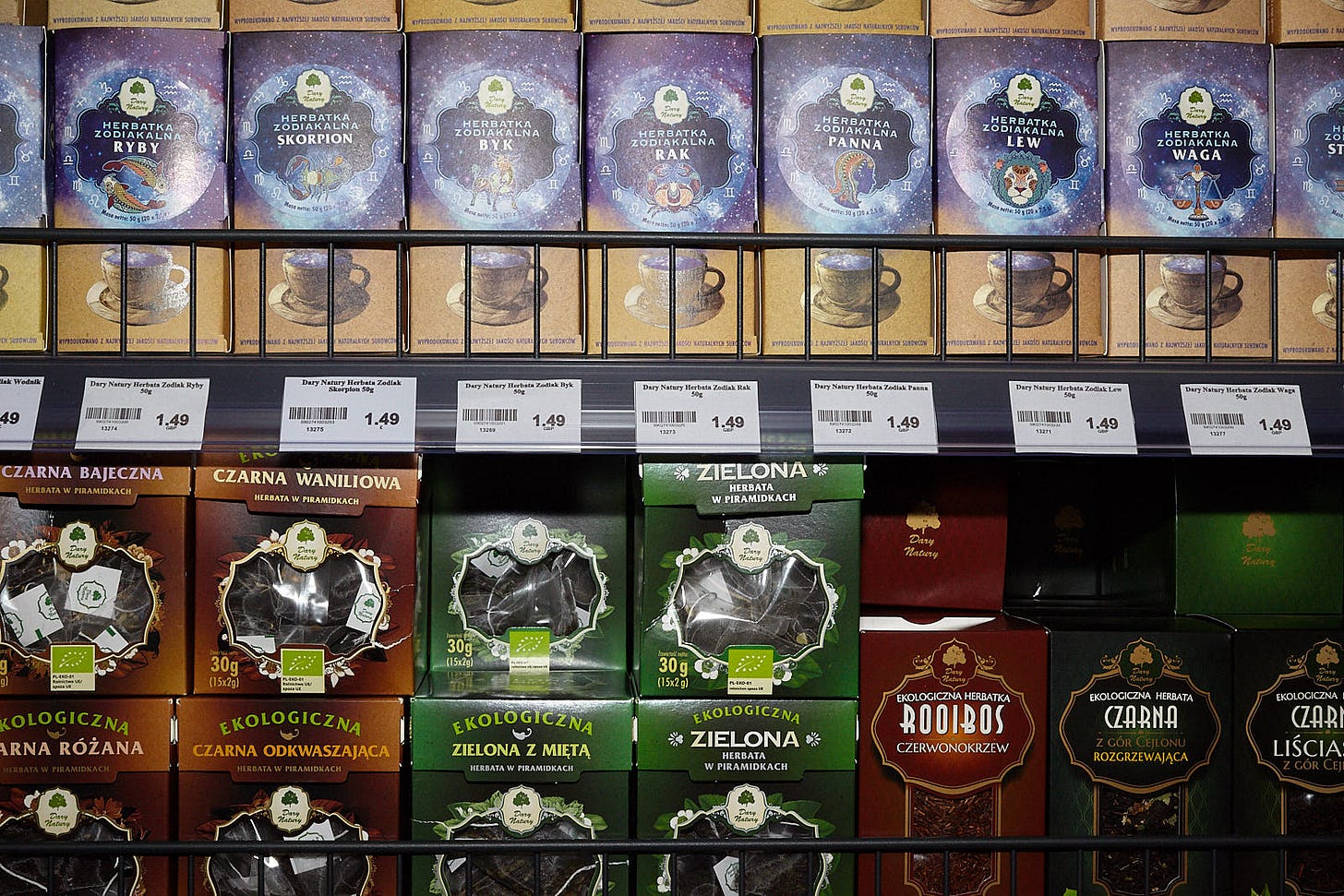A cultural history of the polski sklep
How the polski sklep changed British food culture, by Kasia Tomasiewicz and Marta Zboralska
Good morning and welcome to Vittles. This week, we are publishing two articles on how the accession of the EU8 countries to the European Union twenty years ago changed British food culture. Today’s essay, jointly written by Kasia Tomasiewicz and Marta Zboralska, is on the polski sklep, reflecting on its unlikely influence on British food and high streets, and what it means to the many generations of Poles and non-Poles that it feeds. On Friday, we will publish a guide to London restaurants serving food from the Czech Republic, Estonia, Hungary, Latvia, Lithuania, Poland, Slovakia, and Slovenia.
Also a reminder that our selection of six art prints made in collaboration with illustrator Sing Yun Lee and photographer Michaël Protin are available to buy via our website. This will be the last week you’ll be able to order them in time for Christmas delivery.
A cultural history of the polski sklep
Two Poles of different generations, Kasia Tomasiewicz and Marta Zboralska, reflect on the polski sklep’s contribution to British food culture and what it means to them.
Cultural revolutions are sometimes best encapsulated in food spaces. The expansion of self-service supermarkets in the 1960s, the rise of curry houses during the 1970s, and New Labour’s relentless frequenting of the River Café in the 1990s all say as much about societal change as they do about food. A case might be made that for the long decade from 2004 – when the European Union expanded to include the Czech Republic, Estonia, Hungary, Latvia, Lithuania, Poland, Slovakia, and Slovenia – to the Brexit vote in 2016, the polski sklep was that space.
The polski sklep – usually translated as Polish shop – has thrived on the high street across Britain, from the market town of Huntingdon (the birthplace of Oliver Cromwell, as a recent irate tweet pointed out) to East Belfast, where culturally Catholic polski skleps live among sectarian murals. So ubiquitous is its presence that, after Polish swearwords, ‘polski sklep!’ is usually the first phrase Poles hear from new (but well-meaning) British acquaintances. It’s been an unlikely influence; Poles are not otherwise known for their contribution to the way the British eat. (Have you ever asked friends if they fancy ‘going out for a Polish?’) And yet, traces of its influence can be found everywhere. Kabanosy are now a staple in all corner shops, whether owned by Poles or not. House parties are littered with cans of Tyskie (pronounced a hybrid ‘Tyskee’ rather than the Polish ‘Tysk-yeh’). Polish food now features in most large, as well as smaller, ‘express’ supermarkets in the capital, and is no longer restricted to the dry goods World Foods aisle.
As the official number of Polish residents soared from 69,000 in 2004, post EU-expansion, to just over a million in 2017, the number of skleps in the UK exploded. The Grocer reported that in 2004 there were an estimated twenty-five shops in London restricted to areas with strong existing Polish communities, like Hammersmith and Ealing. By 2014, there were between 450 and 500 across the country.
However, the full story of the sklep is tied to previous migrations, notably the one just after World War 2. Władysław Mleczko, the founder of one of Britain’s largest Polish shop chains, came to live in the UK in 1948, but did not open his first shop until 1996. The Mleczko website claims that, back then, ‘Prices were extremely high and the range of products limited. The market was dominated by a few retailers who saw no reason or were not pressured to change.’ Today, Władysław’s thirteen shops are co-run by his sons, Michael and Tony – an intergenerational enterprise. Władysław claims that, appreciative of the high quality of Polish produce, his English clientele call his shops ‘Polish Waitrose’.
Today, the sklep has morphed into something that means many things to many people: a Polish hub, a British corner shop, and a pan-East European space. Its current form is a result of many generations of migration: from and to Poland; New Europe to the Old; and beyond. With the number of Poles living in the UK falling post-Brexit, the future of the Polish shop will, like its past, necessarily be a hybrid one. For the cashiers, every interaction is a split-second linguistic decision: Dzień dobry? Hello? Some customers are there for a chat with a fellow Pole; at the till, they draw out the conversation, remark on the stock. Regulars know that Friday is the day when the best cakes arrive, in time for the weekend and bought in anticipation of visits from friends and family. These days, Ukrainians are both the sklep’s clientele and staff, their newly acquired Polish far less hesitant than the Polish of native speakers who have long left their homeland. After twenty years of growth, the sklep reminds us that food cultures are never just ours to preserve and inherit, but things we must actively construct.
The old polski sklep
From time immemorial to 2004, by Kasia Tomasiewicz
Like most Poles, the polski sklep runs in my blood. My dad’s family ran a small local shop just outside of Warsaw during World War 2. In a war-torn nation plagued by food shortages, the buying, bartering, and selling of basic commodities was a skill for life. It also made them a target. My grandad sold vodka to occupying Russian troops, and in exchange got a healthy sentence in a Siberian gulag. Still, they kept the shop.
My mum’s parents fared marginally better. Her dad escaped to London at the end of the war and met my grandmother here, only to face hostility from local residents and employers. My grandma worked briefly in a deli in Camden Town in the 1960s, where she tentatively learned the language and culture of her new home. Unable to return to Poland as the Iron Curtain froze, the Polish shop reminded my grandparents of who they were, but also what they had lost. The shops were often discreet spaces for those in the know or connected to local community centres or churches. My church on Devonia Road in Islington had a special ‘shop’ in its basement that was more like a storage cupboard, with a cash till and shelves. It would become lively on weekends with the bustling flow of church goers; I would be awarded with a pączek, a type of lardy Polish doughnut, if I helped with heavy shopping bags.

In the church basement was also a Polish members-style club, symbiotically linked with the shop. Here, after an hour’s worth of rigorous Catholic devotion, ageing mustachioed veterans and heavy-set women whose skirts you got lost in would gossip, drink well-deserved tea or beer, and snack on bread and śledzie. No matter how many small glasses of vodka had been drunk, these members of the old guard always remembered to pick up a jar of ogórki from the sklep before they stumbled out into the fading afternoon light. You didn’t easily nip into these shops – they were dedicated cultural and spiritual investments.
The difficulty for my parents’ generation was not quality (so desperate was the Polish government’s need for money that exporting was prioritised, meaning Polish delis in the UK were well stocked even when there were food shortages in Poland), but finding the places that would sell the right kinds of products in the first place. My grandmother was a bloodhound when it came to this: Italian delis could be mined for dried mushrooms, a staple in Polish stews and pierogi, and Jewish delis from earlier Polish or central European migrations would sell rye bread and herring. A chance encounter in an Austrian deli in Chalk Farm, when she was searching for much-sought-after smoked meats, introduced her to my dad, who had just come over in the wave of 1980s Solidarność (Solidarity) migration when martial law was declared in Poland. Aware of the golden opportunity with which she had been presented, she promptly invited him over for Christmas. Having a son-in-law who knew a guy, who knew another guy, who could get his hands on the best sausages to make bigos, made her a very popular woman.

In the late 1990s, my dad opened his own polski sklep in Ealing. For a brief period, our house was bursting with the plastic fruit, veg, and hams that were to adorn the shop’s interior. It felt like actually living in a shop. I can’t quite remember when the sklep failed, but I remember my dad being annoyed. While his generation of migrants from the 1980s and 1990s were, in small numbers, trying to reinvigorate the post-war Polish community, it was a culture that had become sclerotic. Polish shops had reminded the post-war generation of their homeland but, after forty-five years, their children’s anglicised tastebuds had tried Richmond sausages and Kingsmill bread, and while they weren’t as good as the stuff their babcia would use, they were easier to get your hands on.
When polski skleps began appearing near our house in Hendon around 2004, my mum was amazed. Gone were the long treks across London to find staples. However, these shops were different from the ones we had used before. Polskie Radio Londyn would blare out of shop speakers. I would self-consciously ask questions about products in the proper way, ‘Czy Pani ma…?’ ‘Does the lady have...?’ and would be greeted with bemused looks from shop workers, who wondered why an eleven-year-old sounded like they were in their eighties. Everyone was younger here; they spoke quickly and in slang. They were real Poles, but they also didn’t care if you weren’t. An English friend recently told me of his childhood in Golders Green, getting hot buttered bagels for 20p from the local Jewish bakeries before nipping into a polski sklep to buy deli meats for makeshift sandwiches.
Today, poring over colourful boxes of magical herbal teas and medicinal honey in U Cioici in Edgware, I’ll hear chattering of parents in Polish, their children responding in English. Over the last twenty years, a new first and second generation of Poles has emerged, and it’s nice to recognise in them the conversations I would have once had with my mum. Mish-mashed words, the pleading for sweet treats, and protests of boredom, all fermenting in the polski sklep.
The new polski sklep
From 2004 into the future, by Marta Zboralska
I moved to the UK in 2007, three years after Poland joined the EU, but I do not recall setting foot in a polski sklep until years later. I used to transport Polish snacks in my suitcase: homemade cake, packets of strawberry kisiel and Gorący Kubek sour soup. I would bring back chocolate-covered Ptasie Mleczko marshmallows as a curiosity for friends. Not a single person liked them. And then, as if overnight, they were everywhere, their rubbery texture apparently no longer alien and unpalatable to the average Brit.
Recently, the British polski sklep has been subjected to many of the same changes as convenience stores in Poland. Go to any Polish city and you will find yourself entrapped by Żabka (Little Frog), a corner shop franchise that is taking over smaller chains and replacing local businesses. It is to the urban fabric of Warsaw or Gdańsk what Pret is to Central London. While the franchise model is widely criticised as exploitative, Żabka has transformed the provisions expected of a small inner-city supermarket. The Żabka hot dog – a decidedly continental, vertical affair, the frankfurter poking out of the baguette – is a visually obscene reminder of the hunger for highly processed meat in the land of kiełbasa. It has achieved the status of a cult snack, turning the shops’ employees into hot dog servers first and cashiers second.

Other stores, including my local polski sklep in Lewisham, have since adopted the till-side hot dog station, together with a broad selection of dodgy Fanex-branded condiments, nebulously global in character. Fanex’s English-language website tells me that ‘The most popular Fanex sauces include: Chili Cheese Sauce, Mexican Sauce, 1000 Islands Sauce, Danish Remoulada Sauce, Spicy Sauce with Sambal, Arabic Sauce, Gyro Sauce, Horseradish Sauce, Garlic Sauce, Barbecue Sauce, American Sauce, Garlic sauce with Italian herbs, Basil sauce, Andalusian sauce, Caesar sauce.’ On Lewisham High Street, within a two-minute walk of a new Ecuadorian restaurant, a Lebanese joint, and an Italian deli, the sauces seem especially absurd, all the world reimagined through Polish tastebuds.
My sklep has introduced a point-collecting scheme through a dedicated app, a nod to the one-word question muttered by Żabka cashiers over and over again (‘aplikacja [app]?’). I log on and see that, there, the sklep describes itself as a ‘Polish & European Delicatessen’, mimicking the very British habit – a habit that predates Brexit – of using the word ‘Europe’ as if it does not apply to the United Kingdom; Europe as elsewhere. In Acton, you will find a Żabka imitation, Polska Żabka London, still adorned with a bootleg frog logo (the Polish chain has since moved toward more minimalistic branding). The polski sklep has travelled from Poland to the UK and back again; at the same time, the news of Poland potentially becoming wealthier than Britain by the end of the decade has emerged as a source of much public anxiety.
The sklep is now a place of contrasts, a shop as polski as it is not. It has adapted to a new generation of Poles: beneficiaries of the European Union’s expansion, their tastes decidedly cosmopolitan. It sells (Polish) kombucha and (Polish) kimchi, which sit alongside the more familiar fermented products, sauerkraut and sour gherkins. There is a larger selection of Monmouth Coffee beans here than in most East London delis – you could forget where you were if not for the adjacent posters advertising money transfers to Poland. I spot a photograph of the coffee selection on the shop’s Instagram page, described as ‘Coffee from London / Kawa z Londynu / Кава з Лондона’ – as if the sklep was importing British goods rather than the other way around, like an embassy: Polish soil on foreign land.
Brown bottles of dietary supplement drinks line the shelves, made from ‘superfoods’ both well-known (acai, nettle) and yet to be discovered by Western – and, to be fair, probably most Eastern – European palates: seaberry, white mulberry, rowan berry, cistus. There are ready meals, but they are specifically Polish. Behind the till, a large selection of Polish pharmaceutical items stands directly next to bottles of neat vodka. Despite being greeted with an alarmist anti-debit card poster, no one pays with cash. Polish lager (other than Tyskie and Lech) is found alongside specialist mineral water for therapeutic use in small quantities. Hanging directly above four-packs of Żubr is a picture of John Paul II.
There is something like a World Foods aisle, dedicated to the rest of Eastern Europe and expansive like the EU’s own influence in the region: a famous Czech Coke alternative, Romanian chocolate, Ukrainian baked crisps. Nervous about this rest-of-the-world attitude, a food version of the International Feature Film category at the Oscars, I ask a friend from Moldova how she feels about the Polish shop. She tells me that, as Polish as it might be, it still makes her feel closer to home.
Credits
Kasia Tomasiewicz is a historian of twentieth-century museums and memory studies. She is the co-host of the Cursed Objects podcast.
Marta Zboralska is an art historian working on a book about art and Witold Gombrowicz.
All photographs by Michaël Protin.
The full Vittles masthead can be found here.











Lovely article. Lived in Chorlton in the 70s which had an old-fashioned "Polish grocers store" serving those who had stayed on after the war. Main memory is you had to queue for a very long time to pay as the shopkeeper knew everybody and treated them all as if they had popped in for a cup of tea and a natter.
Great article. i'm off to the sklepy for lunch now for sure!
"I would self-consciously ask questions about products in the proper way, ‘Czy Pani ma…?’ ‘Does the lady have...?’ and would be greeted with bemused looks from shop workers, who wondered why an eleven-year-old sounded like they were in their eighties. "
I loved this bit so much. Thats exactly how i feel when speaking my dated 1970's tinged french, passed down from my mum.